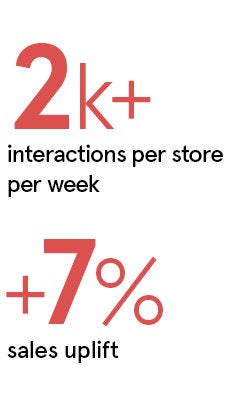The efficiency and immediacy of online shopping has cultivated a desire among consumers for the same experience in-store, with the added value of human interaction. This combination of digitisation and growing customer expectation has reshaped the shopping experience, and transformed the role of physical retail stores.
Changing role of the store
The ability to switch rapidly between online and offline shopping means stores have evolved beyond simply being a sales channel.
Olga Kotsur, co-founder and chief executive of leading retail technology platform Mercaux, says: “Stores now serve as a showroom and marketing channel, becoming a destination for consumers to experience, explore and engage with products, and connect with a brand regardless of where the transaction ultimately takes place.
“Stores have become a hub for brands to cultivate loyalty among customers via a personalised in-store experience. They also need to fulfil orders across all channels, and serve as a data collection and insight centre.”
To adapt to recent changes and be successful, Mercaux advocates that retailers should look towards empowering their most valuable resource, their salespeople in stores.
Mercaux’s customers, including brands such as Karen Millen, Nike and French Connection, agree. They have invested in arming salespeople with digital tools that not only help their staff stay effective and knowledgeable in the increasingly complex retail environment, but also help them provide a totally new level of customer experience.
On the one hand, Mercaux delivers all the product recommendations and stock information online and offline, allowing salespeople to sell effectively across all channels without leaving a customer. On the other hand, it brings digital content, styling suggestions and clientelling capabilities to the shop floor for a truly personalised customer experience.

Human factor
Indeed, the leading differentiator between online and offline shopping is the human aspect. Research by PwC found that 71 per cent of consumers said store associates have a significant impact on their shopping experience.
Ms Kotsur says: “Sales personnel are not only expected to sell products, but are also increasingly viewed by retailers as valued brand ambassadors, personal stylists and product experts. They must display a combination of hard skills with softer, service-orientated skills to serve these increasing expectations.”
For Mercaux, the answer lies in empowering sales assistants through cutting-edge technology. The company’s modular platform features a sales assistant application consisting of a suite of solutions that cover the customer journey in-store from discovery of products through to personal styling and the ability to check out straight from the shop floor.
The app empowers staff with real-time product and stock information, artificial intelligence-driven alternative products and styling suggestions, an in-app looks creation tool, as well as inspirational marketing content. Mercaux also enables salespeople to access customer profiles featuring purchase history and preferences to personalise the interaction.
Ms Kotsur says: “Currently retailers’ IT systems possess powerful information about products and customers, but retailers do not use it in-store. All this information available on the app does not only help sales people in their daily activities, but also vastly improve the experience for customers.”
Testament to Mercaux’s success, Karen Millen experienced a 7 per cent uplift in sales following the adoption of the app that is used by salespeople approximately 2,000 times per store per week.
Not only does Mercaux’s solution empower sales associates, it also provides retailers with vital information about in-store activity, providing real-time visibility of customer behaviour and enabling retailers to develop a single customer view across channels: a “golden record” previously reserved for online.
With Mercaux in stores, retailers are able to digitise the actions of sales personnel, enabling them to know which are the most popular products, which sizes are in greatest demand or how many customers made inquiries. It paints a full picture and builds communication between headquarters and the sales force.
There is undoubtedly more change yet to come, but for those who adopt the right technology and invest in their staff, the future of retail looks positive.
For more information please visit www.mercaux.com



